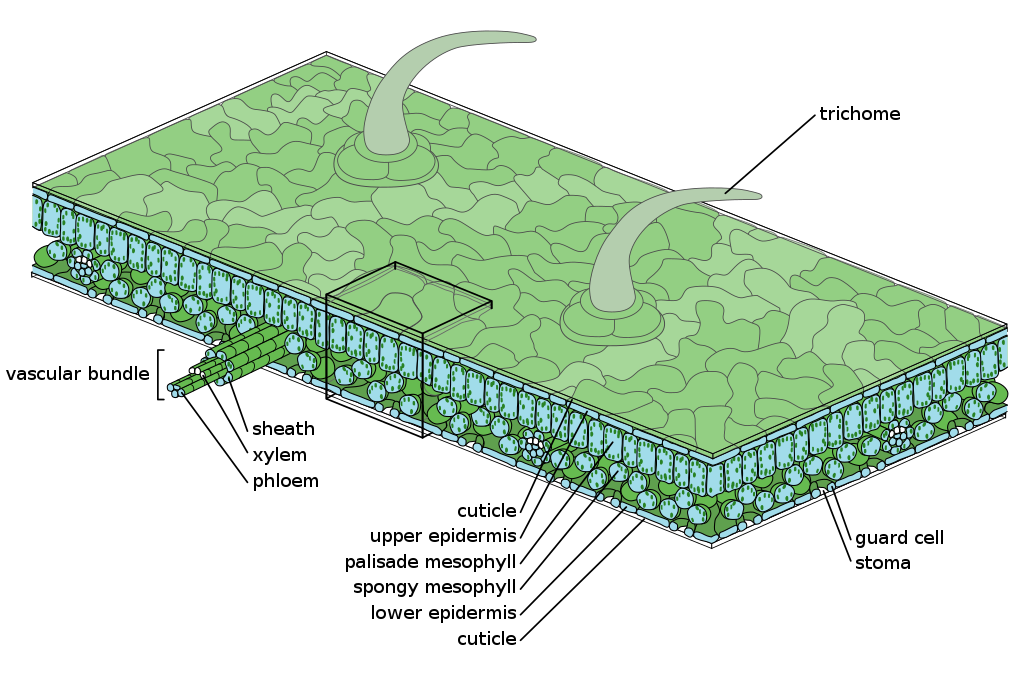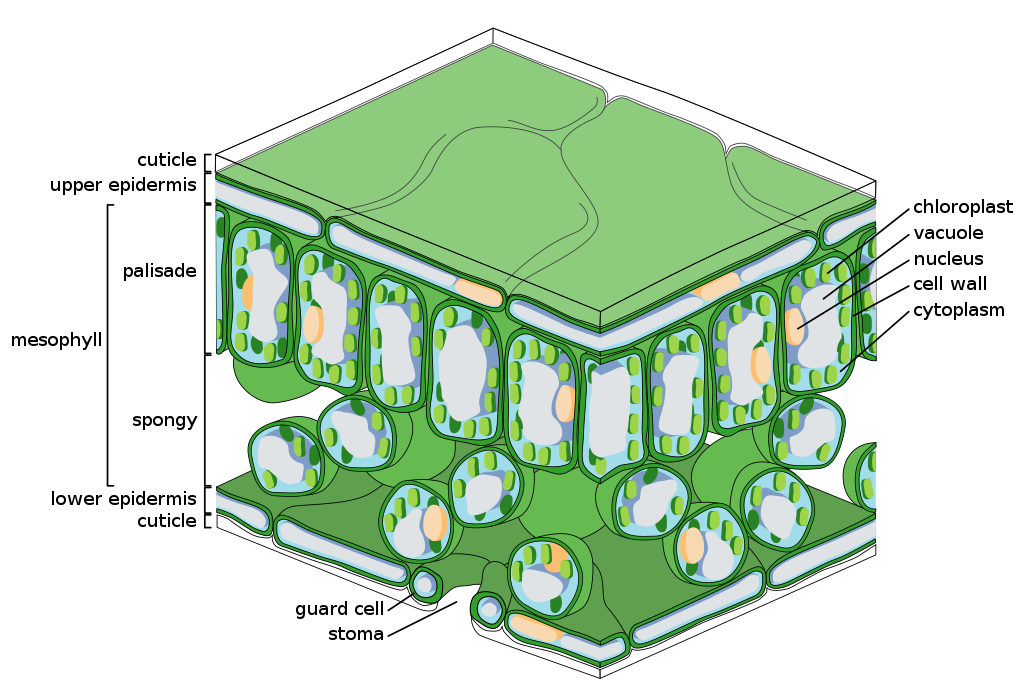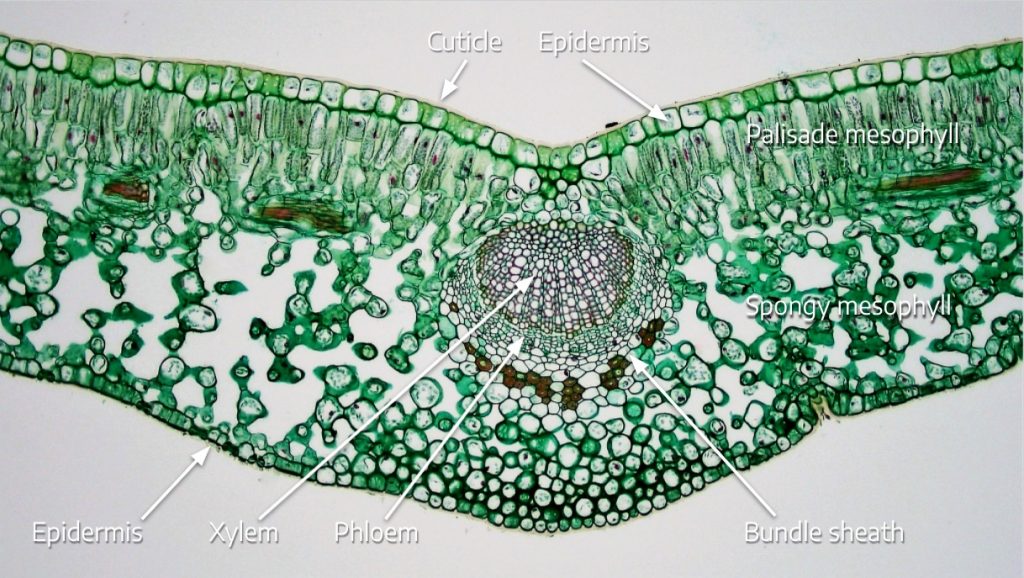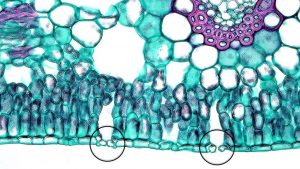5.1 Inside Leaves
Learning objectives
By the end of this lesson you will be able to:
- Recognize the internal cellular structure of leaves.
- Describe how the structure facilitates photosynthesis.
- Describe how the structure facilitates gas exchange.
- Explain why leaves in autumn turn from green to yellow, orange, and red.
Leaf anatomy
Learning leaf anatomy is a bit like taking a sandwich apart and seeing what’s inside. We’ll start with the upper surface and progress down through the leaf. Here are the layers you will find:
- Upper epidermis with cuticle. The cuticle is a protective waxy coating of cutin on epidermis cells, restricting water loss and preventing disease.
- Palisade mesophyll — densely packed, columnar-shaped, elongated cells full of chloroplasts. Chloroplasts are structures inside plant cells that contain chlorophyll and are the site of light capture during photosynthesis. These are analogous to cortex parenchyma cells in the stem, but in the leaf they are specialized for light energy capture.
- Spongy mesophyll — loosely packed cells with large air spaces between them. The air spaces allow movement and exchange of gases, specifically oxygen, carbon dioxide, and water vapor. Spongy mesophyll cells also contain chloroplasts.
- Vascular bundle — xylem, phloem, and bundle sheath cells along with nearby parenchyma and either sclerenchyma or collenchyma fibers for support.
- Lower epidermis with guard cells that regulate the size of the stomata, the gaps in the epidermis that allow gas exchange between the atmosphere and internal parts of the leaf.


In the graphic above, you can see the spongy and palisade mesophyll in detail. During the growing season, these cells are packed with chloroplasts containing the pigment chlorophyll. Chlorophyll absorbs red and blue wavelengths of light to power photosynthesis, and reflects green light back to our eyes, making leaves appear green to use in spring and summer.
Watch this video about colors we see in leaves:
Review this article, Why Leaves Change Color.
Chromoplasts (not to be confused with chloroplasts) are cellular organelles that contain types and colors of pigments other than the chlorophyll found in chloroplasts. In late summer and fall, the mesophyll cell chloroplasts produce chlorophyll at a slower rate than earlier in the year. As the existing chlorophyll reaches the end of its functional lifespan and eventually degenerates, the amount of chlorophyll declines over time. Because chlorophyll replacement doesn’t make up for chlorophyll loss, the green color fades from the leaves. Meanwhile, the non-green pigments in the chromoplasts hold their own or increase in quantity, including the yellow and orange from the carotenoid pigments and the red from the anthocyanin pigments.
Carotenoid pigments are present in the leaf all growing season, but during the warm part of the season they’re hidden by the high concentration of green-colored chlorophyll. When the cool autumn weather comes, the days shorten and the chlorophyll concentration in the chloroplasts declines. The carotenoids in the chromoplasts don’t degenerate as quickly as the chlorophyll does, so we get a beautiful display of oranges and yellows in the leaves once the green is gone. These orange and yellow colors can be counted on every year because the carotenoids are produced and present all year long.
In contrast to the carotenoid pigments, the amount of red color in leaves from the anthocyanins differs from autumn to autumn. Anthocyanins are produced primarily in the autumn in response to bright light and excess plant sugars in leaf cells. Warm, sunny days encourage sugar production in leaf mesophyll, and cool nights hinder the transport of these sugars out of the cells, so the sugars stay in leaves. The high sugar then stimulates anthocyanin production. Warm, bright days + cool nights = red leaves. In years with overcast days and warmer nights, there is less sugar production in the leaves and the sugars translocate (move out) from the leaf mesophyll cells to other locations in the tree, so there is less anthocyanin pigment produced and less red color in the leaves. You might see this happening on individual trees: on the sunlit, southwest side of the tree you might find leaves with more red than on the shaded, northeast side. This effect of weather on anthocyanin is particularly noticeable in trees such as sugar maples.
Some other woody plants, like sumac, seem to be bright red in later September and early October regardless of the weather conditions. Other trees, like birch and oak, will be yellow or tan even with warm bright days and cool nights.
Here is a cross section of a pear leaf showing the same cells illustrated in the graphic shown earlier.

The palisade mesophyll is highly adapted for capturing light energy. As noted earlier, the cells are packed tightly together, filled with chloroplasts, and make up the cell layer just under the protective epidermis on the top surface of the leaf oriented toward the sun. The spongy mesophyll cells below the palisade layer are less densely packed together, so the region is laced with air channels. This makes the spongy mesophyll highly adapted for gas movement and air exchange around the cells.

Guard cells surround a gap in the epidermis. This gap is called a stoma or stomate (plural = stomata), and is the portal through which gas exchanges between the interior and exterior of the leaf. Gases in the intercellular spaces between spongy mesophyll cells are free to move out of the stomata into the atmosphere, and atmospheric gasses are free to move in. As we will see later when we address photosynthesis, healthy plants must have the ability to move oxygen (a waste product of photosynthesis) out of the leaf, and carbon dioxide (a raw material for building sugars) into the leaf. Water vapor must also be able to move out of the leaf as part of the transpiration process.
The vascular bundle (the xylem and phloem in the graphic above) is highly adapted for transport of fluids. Water and dissolved minerals move up the xylem from the roots and into the leaf. Sugars produced in the leaf during photosynthesis move out of the leaf through the phloem and are translocated to other parts of the plant. The thick-walled bundle sheath cells that surround the xylem and phloem provide mechanical support, and contribute to some types of photosynthesis. Wikipedia has a good illustration showing the tissues associated with the vascular bundles. Take a look.
Review questions
- Which layer of cells in the leaf are most highly adapted to intercept light? Describe three ways in which these cells are specialized for this purpose. Hint: two have to do with position or orientation in the leaf, and one with the plastids they contain.
- Which leaf cell layers are key to gas exchange?
- What happens to the green pigments in leaves when the weather turns cold in the fall? Why do some leaves turn yellow, orange, and red, instead of turning brown?
Protective waxy coating of cutin on epidermis cells that restricts water loss.
Water-resistant substance that coats the wall of the cell exposed to the environment and helps limit the loss of water that is inside of the plant to the atmosphere.
Also known as the ground meristem, is found just inside the epidermis and extends toward the interior of the stem and root, and is made up of three types of cells: parenchyma, collenchyma, and sclerenchyma.
System containing vessels that carry or circulate fluids and dissolved minerals in the plant; composed of xylem, phloem, and bundle sheath cells.
Supporting and water-conducting tissue of vascular plants.
Tissue consisting of sieve tube and companion cells in the vascular system of plants that moves dissolved sugars and other products of photosynthesis from the leaves to other regions of the plant.
Located on the epidermis and regulate the size of the stomata.
Gap in the epidermis that allows gas exchange between the atmosphere and internal parts of the leaf.
Yellow and orange pigments that are present in the leaf all growing season, but during the warm part of the season these colors are hidden by the high concentration of green-colored chlorophyll. They take longer to break down than chlorophyll.
Red pigments that are produced primarily in the autumn in response to bright light and excess plant sugars in leaf cells.

